Satas D., Tracton A.A. (ed.). Coatings Technology Handbook
Подождите немного. Документ загружается.


332
RATHMELL
proach is not always applicable. but
it
can be very much less expensive where the dryers
for a coated web and condensers are designed as a system.
4.1
Carbon Adsorption
When
a
carbon bed is installed
to
capture solvent vapors exhausted with air from a dryer.
it
is usual
to
provide two or more carbon beds and to periodically desorb from one while
adsorbing
in
the other(s). Desorption is accomplished by heating the bed and sweeping
the vapors
out,
typically with steam.
The steam and vapors are then condensed, and the steam condensate (water) must
be separated from solvent. Typically about
3-4
or up to
IO
Ib of stem is used per pound
of
solvent recovered.
If
the recovered solvent is soluble
in
water. (alcohols. ketones, etc.),
the need to separate the water presents additional expenses. Some vapors, such
as
methyl
ethyl ketone. absorb onto carbon with
so
much heat release that precautions are needed
to
prevent spontaneous ignition from burning up the air-swept carbon bed.
There are many carbon adsorption systems in which the value of solvent recovered
exceeds the cost of operation. Often. however, it costs more to recover the solvent than
to
buy new solvent.
In
such cases. the higher recovery cost is charged to the need to avoid
air pollution.
4.2
Direct Vapor Condensation
Direct vapor condensation can be more economical than using carbon beds for solvent
recovery. The energy consumption is usually less than
10%
of
the energy
to
operate a
conventional air-swept dryer and carbon bed. and there is
no
water added
to
the solvent
by the process.
Also,
there is
no
exhaust flow
to
the atmosphere
in
the preferred designs.
The vapor condensers are much smaller than required for carbon bed recovery system.
and there is another advantage
in
that when two or more dryers are operated with different
solvents or blends
of
solvents, separate vapor condensers avoid the mixing
of
solvents
and the costs of separating them. Usually a water chiller type of refrigeration system is
required, but one system can serve all the condensers.
However, there are limitations on the applicability
of
this process: the process dryers
must be substantially “airtight”
to
permit the contained atmosphere be recirculated count-
less times with a minimum of interchange with outside atmosphere. Indirect heaters. such
as steam coils, are necessary.
Also,
the oxygen level
in
the contained atmosphere should
be kept below the limit
(10-1396
02)
that would sustain combustion; otherwise
it
is
necessary
to
use very cold condensers and relatively high recirculation rates to keep the
vapor levels safely below the vapor
LEL
limits. There is a need for a relatively small t’low
of inert (low oxygen content) gas to offset the tendency for the wet web
to
drag air
(218
01)
into
the dryer. and it is necessary
to
maintain a ready reservoir of pressurized inert
gas (a) to facilitate a rapid air purge and dryer start-up after the dryer has been opened
for any reason. and (b) to provide
a
safety cushion for a fail-safe shutdown during an
electrical power outage.
The sources of inert (low oxygen) gas required include the flue gas of a gas-fired
steam boiler and purchased liquid nitrogen or carbon dioxide. Where flue gases are used.
the gas burner must be of the type that can maintain a low ratio of excess air to fuel for
various fuel firing rates.
A
compressor and pressurized storage tank can provide the ready
reservoir for fast start-up and fail-safe shutdowns. or
a
tank
of
liquid nitrogen with vapor-
ization facilities can be used.
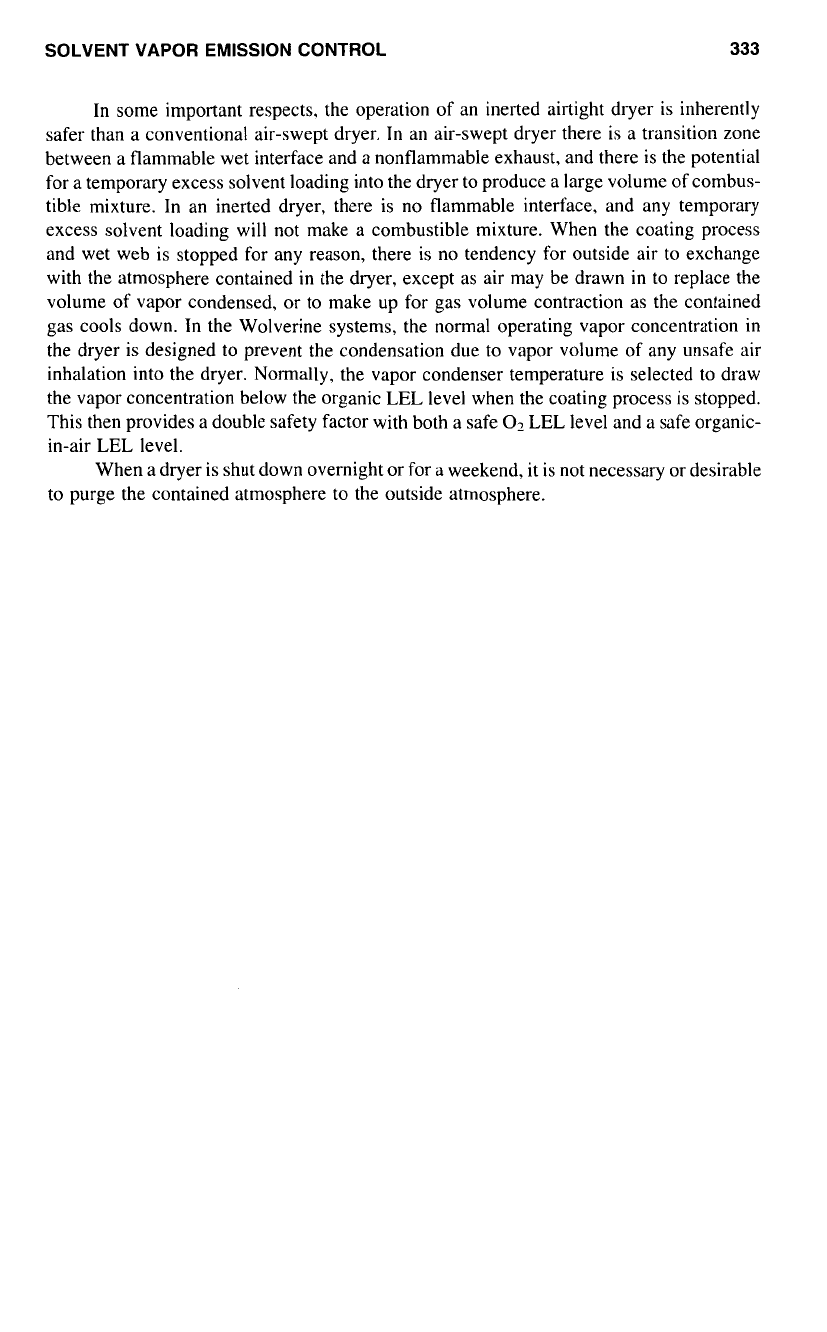
SOLVENT VAPOR EMISSION CONTROL
333
In some important respects, the operation of an inerted airtight dryer is inherently
safer than a conventional air-swept dryer. In an air-swept dryer there is
a
transition zone
between a flammable wet interface and
a
nonflammable exhaust, and there is the potential
for a temporary excess solvent loading into the dryer
to
produce a large volume of combus-
tible mixture. In an inerted dryer, there is no flammable interface, and any temporary
excess solvent loading will not make a combustible mixture. When the coating process
and wet web is stopped for any reason, there is no tendency for outside air to exchange
with the atmosphere contained in the dryer, except
as
air may be drawn
in
to replace the
volume
of
vapor condensed,
or
to make up for gas volume contraction as the contained
gas cools down. In the Wolverine systems, the normal operating vapor concentration in
the dryer
is
designed
to
prevent the condensation due
to
vapor volume of any unsafe air
inhalation into the dryer. Normally, the vapor condenser temperature is selected to draw
the vapor concentration below the organic LEL level when the coating process
is
stopped.
This then provides
a
double safety factor with both a safe
O2
LEL level and a safe organic-
in-air LEL level.
When a dryer is shut down overnight
or
for a weekend, it is not necessary
or
desirable
to purge the contained atmosphere to the outside atmosphere.
This Page Intentionally Left Blank
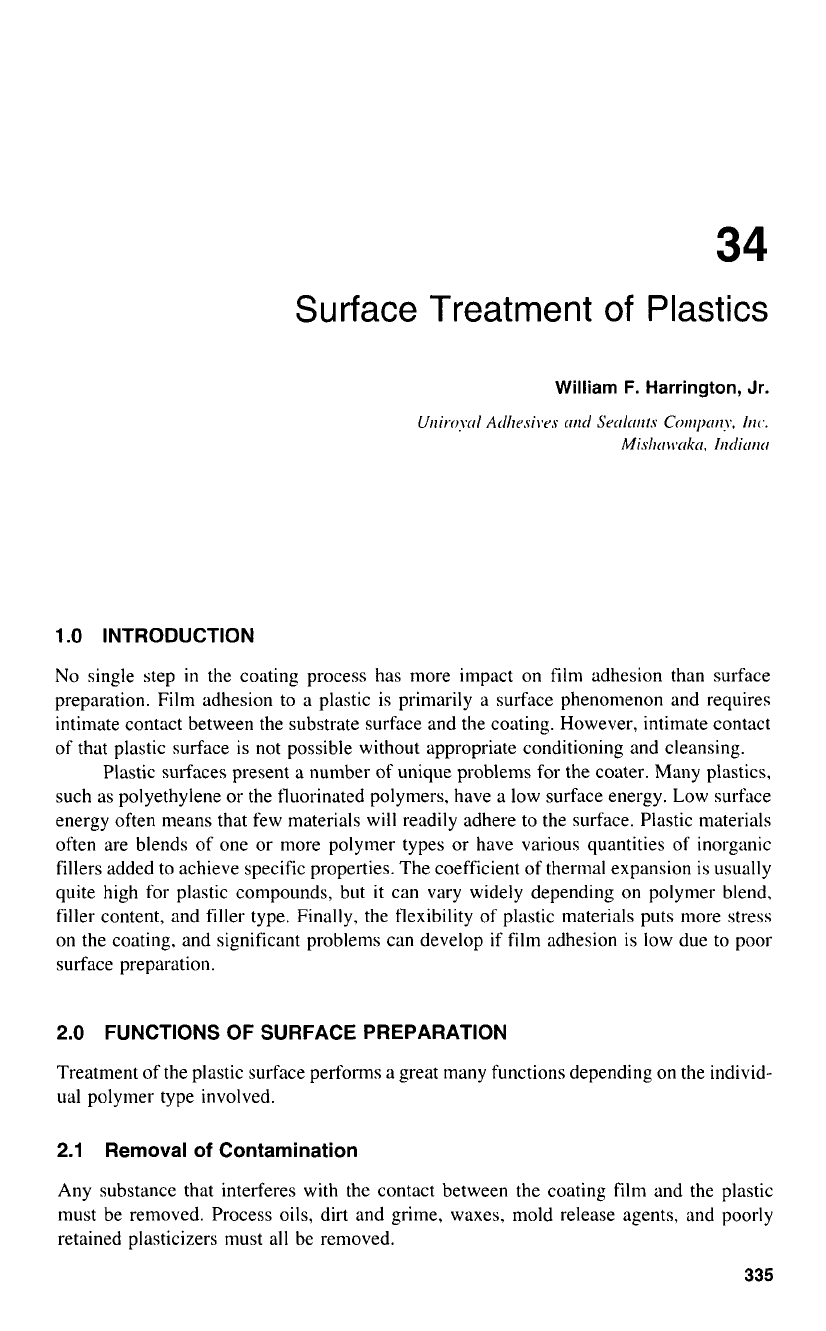
34
Surface Treatment
of
Plastics
1
.O
INTRODUCTION
No
single step
in
the coating process has more impact on film adhesion than surface
preparation. Film adhesion
to
a plastic is primarily a surface phenomenon and requires
intimate contact between the substrate surface and the coating. However, intimate contact
of that plastic surface is not possible without appropriate conditioning and cleansing.
Plastic surfaces present a number
of
unique problems for the coater. Many plastics,
such as polyethylene or the tluorinated polymers, have a low surface energy. Low surface
energy often means that few materials will readily adhere to the surface. Plastic materials
often are blends of one or more polymer types or have various quantities of inorganic
fillers added to achieve specific properties. The coefficient of thermal expansion is usually
quite high for plastic compounds, but it can vary widely depending
on
polymer blend,
filler content, and filler type. Finally, the tlexibility
of
plastic materials puts more stress
on the coating. and significant problems can develop
if
film adhesion is low due to poor
surface preparation.
2.0
FUNCTIONS OF SURFACE PREPARATION
Treatment
of
the plastic surface performs a great many functions depending on the individ-
ual polymer type involved.
2.1
Removal
of
Contamination
Any substance that interferes with the contact between the coating film and the plastic
must be removed. Process oils, dirt and grime, waxes, mold release agents, and poorly
retained plasticizers must
all
be removed.
335
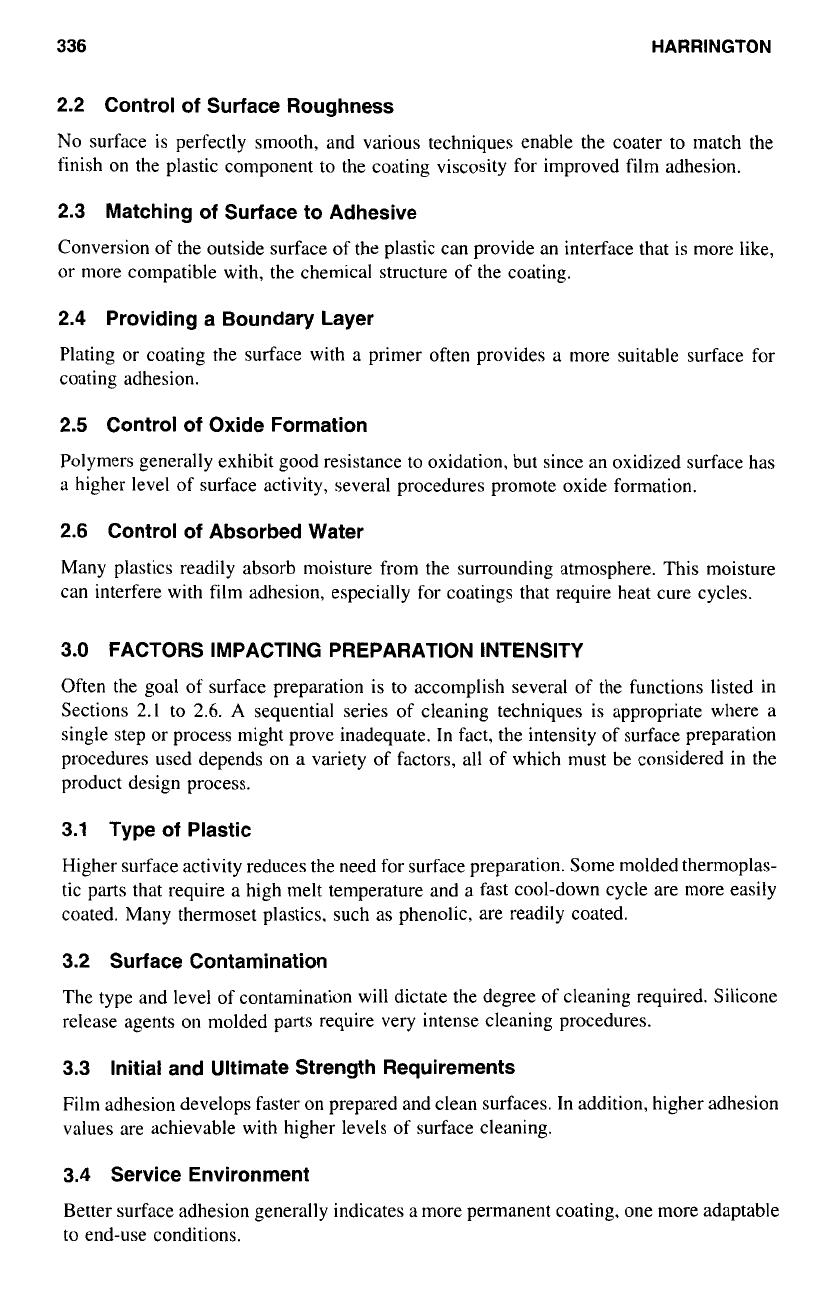
336
HARRINGTON
2.2 Control
of
Surface Roughness
No
surface is perfectly smooth, and various techniques enable the coater to match the
finish on the plastic component to the coating viscosity for improved film adhesion.
2.3 Matching of Surface to Adhesive
Conversion of the outside surface
of
the plastic can provide an interface that is more like,
or more compatible with, the chemical structure of the coating.
2.4 Providing a Boundary Layer
Plating or coating the surface with a primer often provides a more suitable surface for
coating adhesion.
2.5 Control
of
Oxide Formation
Polymers generally exhibit good resistance to oxidation, but since an oxidized surface has
a
higher level
of
surface activity, several procedures promote oxide formation.
2.6
Control
of
Absorbed Water
Many plastics readily absorb moisture from the surrounding atmosphere. This moisture
can interfere with film adhesion, especially for coatings that require heat cure cycles.
3.0 FACTORS IMPACTING PREPARATION INTENSITY
Often the goal of surface preparation is to accomplish several of the functions listed in
Sections
2.1
to
2.6.
A
sequential series of cleaning techniques is appropriate where a
single step or process might prove inadequate. In fact, the intensity of surface preparation
procedures used depends on a variety of factors, all
of
which must be considered in the
product design process.
3.1
Type of Plastic
Higher surface activity reduces the need for surface preparation. Some molded thermoplas-
tic parts that require
a
high melt temperature and a fast cool-down cycle are more easily
coated. Many thermoset plastics, such as phenolic, are readily coated.
3.2 Surface Contamination
The type and level of contamination will dictate the degree of cleaning required. Silicone
release agents on molded parts require very intense cleaning procedures.
3.3 Initial and Ultimate Strength Requirements
Film adhesion develops faster on prepared and clean surfaces. In addition, higher adhesion
values are achievable with higher levels of surface cleaning.
3.4 Service Environment
Better surface adhesion generally indicates
a
more permanent coating, one more adaptable
to
end-use conditions.
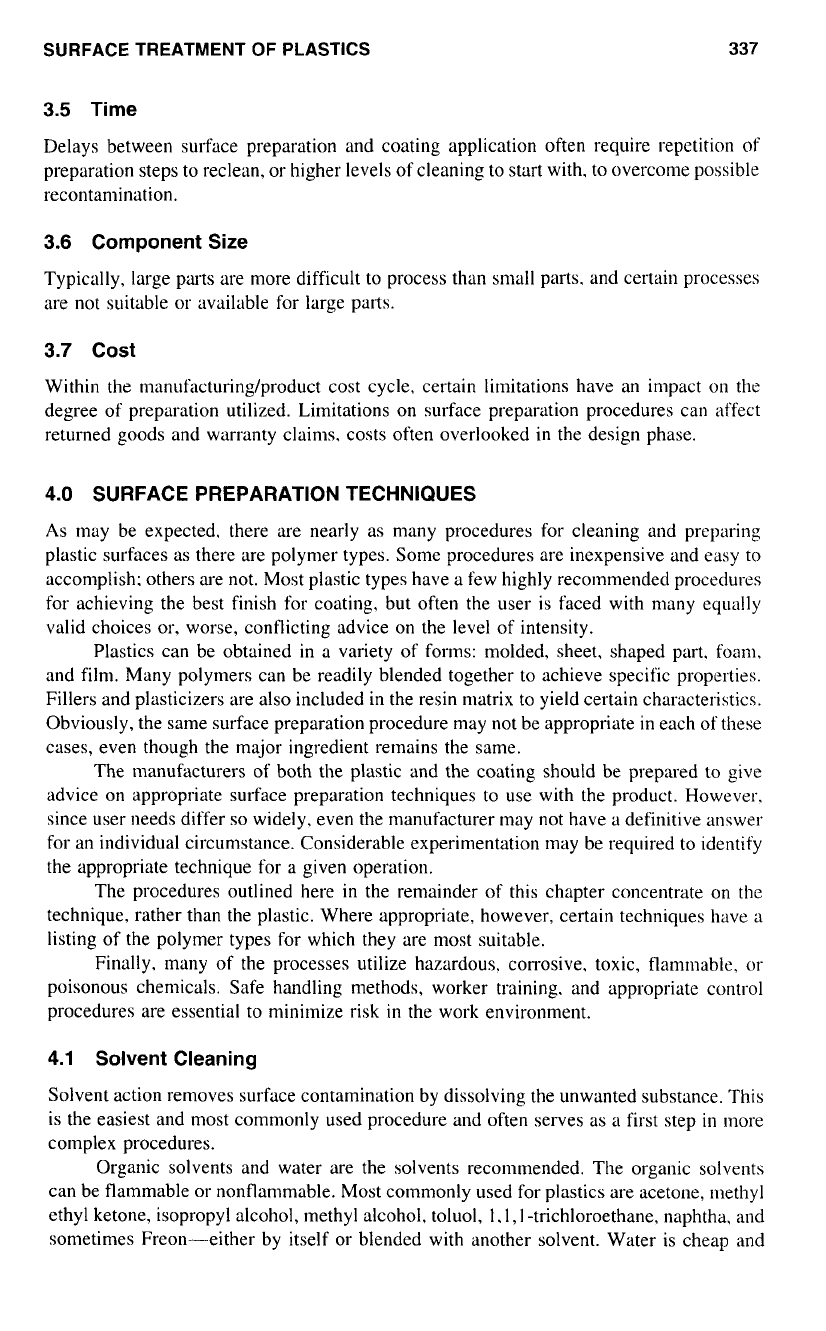
SURFACE TREATMENT OF PLASTICS
337
3.5
Time
Delays between surface preparation and coating application often require repetition of
preparation steps to reclean, or higher levels of cleaning to start with,
to
overcome possible
recontamination.
3.6
Component Size
Typically, large parts are more difficult to process than small parts. and certain processes
are not suitable or available for large parts.
3.7
cost
Within the manufacturing/product cost cycle, certain limitations have an impact
on
the
degree of preparation utilized. Limitations on surface preparation procedures can affect
returned goods and warranty claims, costs often overlooked in the design phase.
4.0
SURFACE PREPARATION TECHNIQUES
As
may be expected. there are nearly as many procedures for cleaning and preparing
plastic surfaces as there are polymer types. Some procedures are inexpensive and easy
to
accomplish: others are not. Most plastic types have a few highly recommended procedures
for achieving the best finish for coating, but often the user is faced with many equally
valid choices or, worse, conflicting advice on the level of intensity.
Plastics can be obtained
in
a variety
of
forms: molded, sheet, shaped part. foam,
and film. Many polymers can be readily blended together to achieve specific properties.
Fillers and plasticizers are also included in the resin matrix to yield certain characteristics.
Obviously, the same surface preparation procedure may not be appropriate
in
each of these
cases, even though the major ingredient remains the same.
The manufacturers of both the plastic and the coating should be prepared to give
advice on appropriate surface preparation techniques to use with the product. However.
since user needs differ
so
widely, even the manufacturer may not have a definitive answer
for an individual circumstance. Considerable experimentation may be required to identify
the appropriate technique for a given operation.
The procedures outlined here
in
the remainder
of
this chapter concentrate
on
the
technique, rather than the plastic. Where appropriate, however, certain techniques have
a
listing
of
the polymer types for which they are most suitable.
Finally. many
of
the processes utilize hazardous. conosive. toxic, flammable.
or
poisonous chemicals. Safe handling methods, worker training. and appropriate control
procedures are essential to minimize risk
in
the work environment.
4.1
Solvent Cleaning
Solvent action removes surface contamination by dissolving the unwanted substance. This
is the easiest and most commonly used procedure and often serves as
a
first step
in
more
complex procedures.
Organic solvents and water are the solvents recommended. The organic solvents
can be flammable or nonflammable. Most commonly used for plastics are acetone, methyl
ethyl ketone, isopropyl alcohol, methyl alcohol, toluol,
1.
I,
1
-trichloroethane, naphtha, and
sometimes Freon-either by itself or blended with another solvent. Water is cheap and
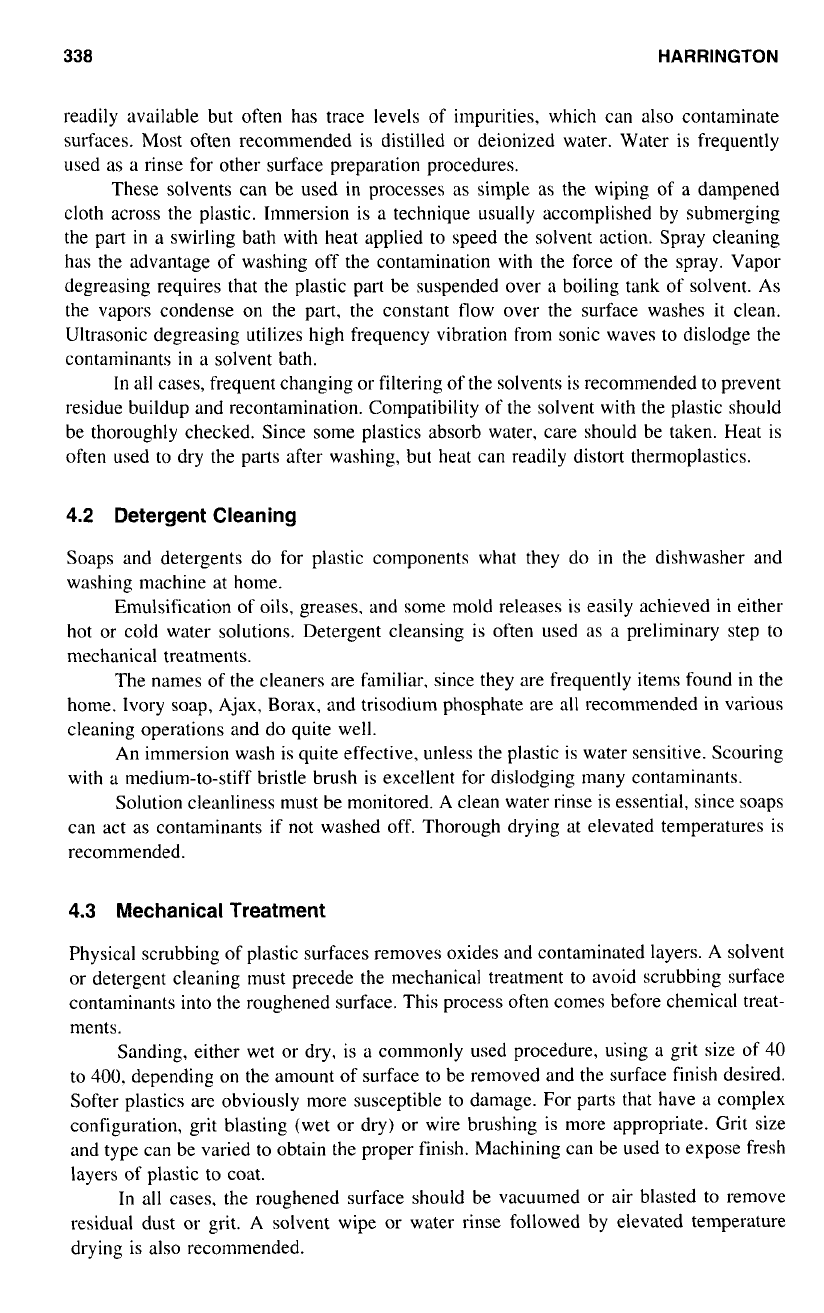
338
HARRINGTON
readily available but often has trace levels of impurities, which can also contaminate
surfaces. Most often recommended is distilled or deionized water. Water is frequently
used as a rinse for other surface preparation procedures.
These solvents can be used in processes
as
simple
as
the wiping
of
a
dampened
cloth across the plastic. Immersion is
a
technique usually accomplished by submerging
the part
in
a swirling bath with heat applied to speed the solvent action. Spray cleaning
has the advantage of washing off the contamination with the force of the spray. Vapor
degreasing requires that the plastic part be suspended over
a
boiling tank of solvent. As
the vapors condense
on
the part, the constant flow over the surface washes it clean.
Ultrasonic degreasing utilizes high frequency vibration from sonic waves
to
dislodge the
contaminants
in
a solvent bath.
In
all cases, frequent changing or filtering of the solvents is recommended to prevent
residue buildup and recontamination. Compatibility of the solvent with the plastic should
be thoroughly checked. Since some plastics absorb water. care should be taken. Heat is
often used to dry the parts after washing, but heat can readily distort thermoplastics.
4.2
Detergent Cleaning
Soaps and detergents do for plastic components what they do in the dishwasher and
washing machine at home.
Emulsification
of
oils, greases. and some mold releases is easily achieved
in
either
hot or cold water solutions. Detergent cleansing is often used as
a
preliminary step to
mechanical treatments.
The names of the cleaners are familiar. since they are frequently items found in the
home. Ivory soap, Ajax, Borax, and trisodium phosphate are
all
recommended in various
cleaning operations and do quite well.
An immersion wash is quite effective, unless the plastic is water sensitive. Scouring
with a medium-to-stiff bristle brush is excellent for dislodging many contaminants.
Solution cleanliness must be monitored. A clean water rinse is essential, since soaps
can act as contaminants
if
not washed off. Thorough drying at elevated temperatures is
recommended.
4.3
Mechanical Treatment
Physical scrubbing of plastic surfaces removes oxides and contaminated layers. A solvent
or detergent cleaning must precede the mechanical treatment to avoid scrubbing surface
contaminants into the roughened surface. This process often comes before chemic,
‘1
I
treat-
ments.
Sanding, either wet or dry, is a commonly used procedure, using a grit size of
40
to
400.
depending on the amount
of
surface to be removed and the surface finish desired.
Softer plastics are obviously more susceptible to damage. For parts that have a complex
configuration, grit blasting (wet or dry) or wire brushing is more appropriate. Grit size
and type can be varied to obtain the proper finish. Machining can be used to expose fresh
layers
of
plastic to coat.
In
all
cases, the roughened surface should be vacuumed or air blasted to remove
residual dust or grit. A solvent wipe or water rinse followed by elevated temperature
drying is also recommended.
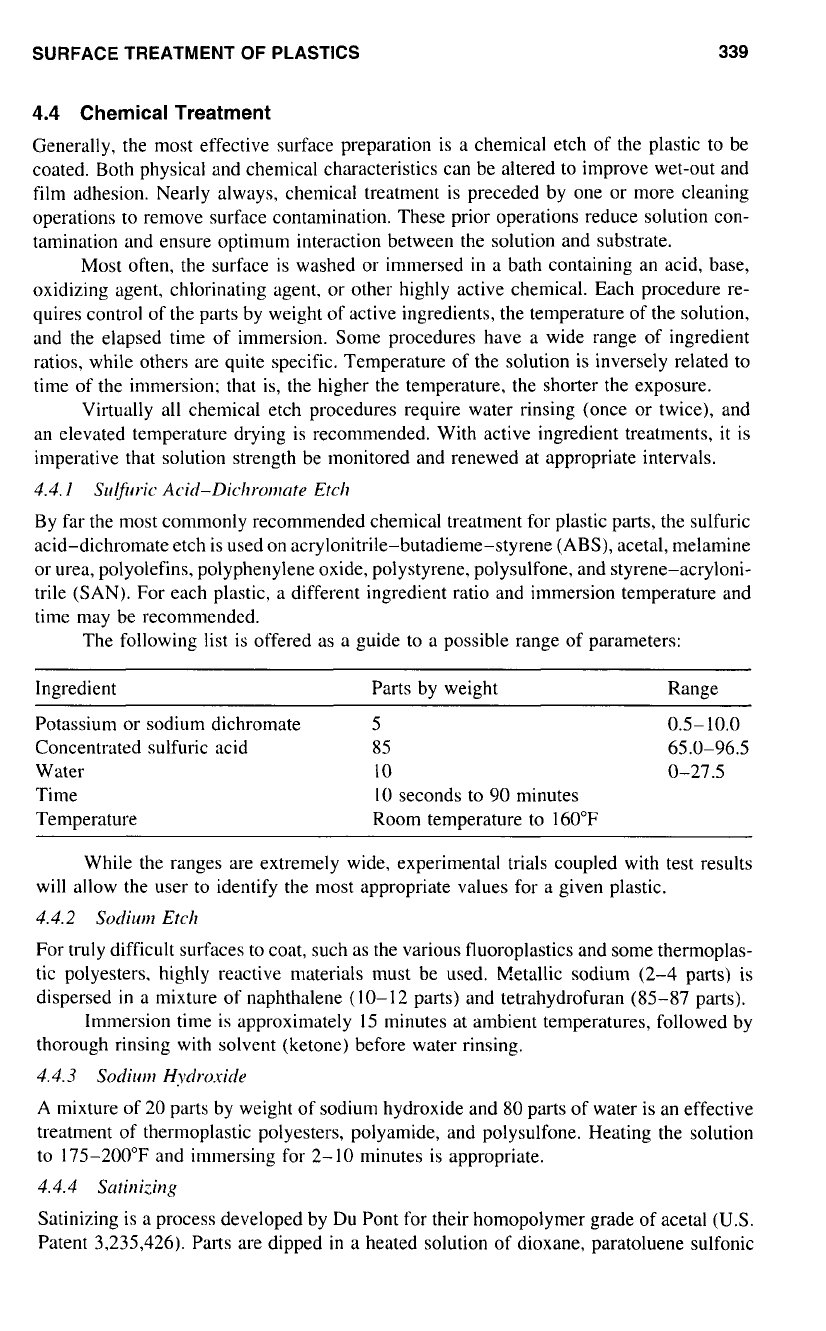
SURFACE TREATMENT OF PLASTICS
339
4.4
Chemical Treatment
Generally, the most effective surface preparation is a chemical etch of the plastic
to
be
coated. Both physical and chemical characteristics can be altered to improve wet-out and
film adhesion. Nearly always, chemical treatment is preceded by one or more cleaning
operations to remove surface contamination. These prior operations reduce solution con-
tamination and ensure optimum interaction between the solution and substrate.
Most often, the surface is washed or immersed
in
a bath containing an acid, base,
oxidizing agent, chlorinating agent. or other highly active chemical. Each procedure re-
quires control of the parts by weight
of
active ingredients, the temperature of the solution,
and the elapsed time of immersion. Some procedures have a wide range
of
ingredient
ratios, while others are quite specific. Temperature
of
the solution is inversely related to
time of the immersion; that
is,
the higher the temperature, the shorter the exposure.
Virtually
all
chemical etch procedures require water rinsing (once or twice), and
an elevated temperature drying is recommended. With active ingredient treatments,
it
is
imperative that solution strength be monitored and renewed at appropriate intervals.
4.4.
l
Sulfrrric Acitl-Dichronrcrte
Etch
By far the most commonly recommended chemical treatment for plastic parts, the sulfuric
acid-dichromate etch is used
on
acrylonitrile-butadieme-styrene
(ABS), acetal, melamine
or urea, polyolefins, polyphenylene oxide, polystyrene, polysulfone, and styrene-acryloni-
trile (SAN). For each plastic, a different ingredient ratio and immersion temperature and
time may be recommended.
The following list is offered as a guide to a possible range of parameters:
Ingredient Parts by weight Range
Potassium or sodium dichromate
5
0.5-10.0
Concentrated sulfuric acid
85 65.0-96.5
Water
IO
0-27.5
Time
IO
seconds
to
90 minutes
Temperature
Room temperature to 160°F
While the ranges are extremely wide, experimental trials coupled with test results
will allow the user to identify the most appropriate values for a given plastic.
4.4.2
Sodium
Etch
For truly difficult surfaces
to
coat, such as the various fluoroplastics and some thermoplas-
tic polyesters. highly reactive materials must be used. Metallic sodium (2-4 parts) is
dispersed
in
a mixture
of
naphthalene (10-12 parts) and tetrahydrofuran (85-87 parts).
Immersion time is approximately
15
minutes at ambient temperatures, followed by
thorough rinsing with solvent (ketone) before water rinsing.
4.4.3
Sodium
Hydroxide
A mixture of 20 parts by weight of sodium hydroxide and 80 parts of water is an effective
treatment
of
thermoplastic polyesters, polyamide, and polysulfone. Heating the solution
to 175-200°F and immersing for
2-10
minutes is appropriate.
4.4.4
Satinizing
Satinizing
is
a process developed by Du Pont for their homopolymer grade of acetal
(U.S.
Patent 3,235,426). Parts are dipped
in
a heated solution of dioxane, paratoluene sulfonic
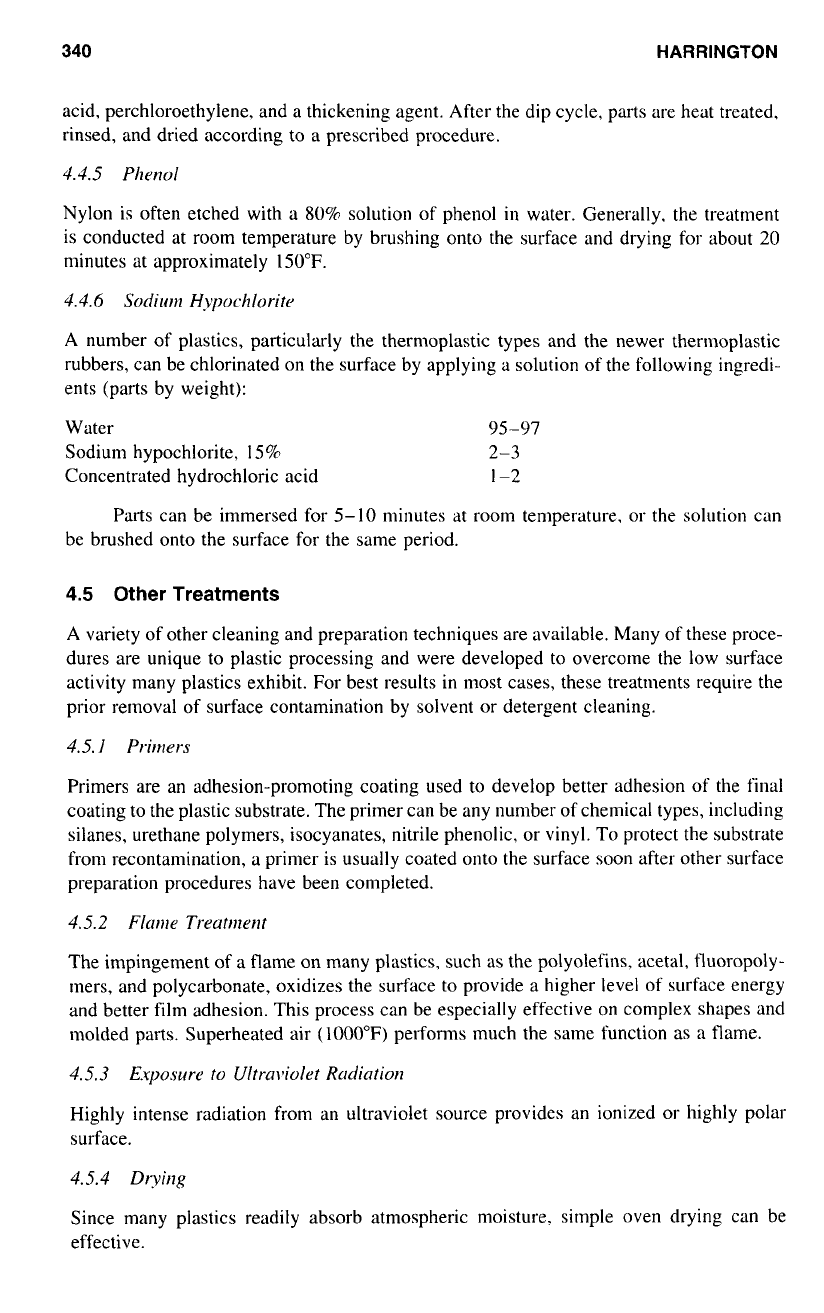
340
HARRINGTON
acid, perchloroethylene, and a thickening agent. After the dip cycle, parts are heat treated,
rinsed, and dried according to a prescribed procedure.
4.4.5
Phenol
Nylon is often etched with a
80%
solution of phenol
in
water. Generally. the treatment
is conducted at room temperature by brushing onto the surface and drying for about
20
minutes at approximately
150°F.
4.4.6
Sodim
Hypochlorito
A
number
of
plastics, particularly the thermoplastic types and the newer thermoplastic
rubbers, can be chlorinated on the surface by applying a solution of the following ingredi-
ents (parts by weight):
Water
Sodium hypochlorite,
15%
Concentrated hydrochloric acid
95-97
2-3
1-2
Parts can be immersed for
5-10
minutes at room temperature. or the solution can
be brushed onto the surface for the same period.
4.5
Other Treatments
A variety of other cleaning and preparation techniques are available. Many of these proce-
dures are unique to plastic processing and were developed
to
overcome the
low
surface
activity many plastics exhibit. For best results in most cases, these treatments require the
prior removal of surface contamination by solvent or detergent cleaning.
4.5.
I
Primers
Primers are an adhesion-promoting coating used to develop better adhesion
of
the final
coating to the plastic substrate. The primer can be any number of chemical types, including
silanes, urethane polymers, isocyanates, nitrile phenolic, or vinyl. To protect the substrate
from recontamination, a primer is usually coated onto the surface
soon
after other surface
preparation procedures have been completed.
4.5.2
Flarw
Treuttlmt
The impingement
of
a flame
on
many plastics. such as the polyolefins. acetal, tluoropoly-
mers, and polycarbonate, oxidizes the surface
to
provide a higher level of surface energy
and better film adhesion. This process can be especially effective
on
complex shapes and
molded parts. Superheated air
(1000°F)
performs much the same function as a flame.
4.5.3
Expsure
to
Ultraviolet
Rdiation
Highly intense radiation from an ultraviolet source provides an ionized or highly polar
surface.
4.5.4
Dtyirtg
Since many plastics readily absorb atmospheric moisture. simple oven drying can be
effective.
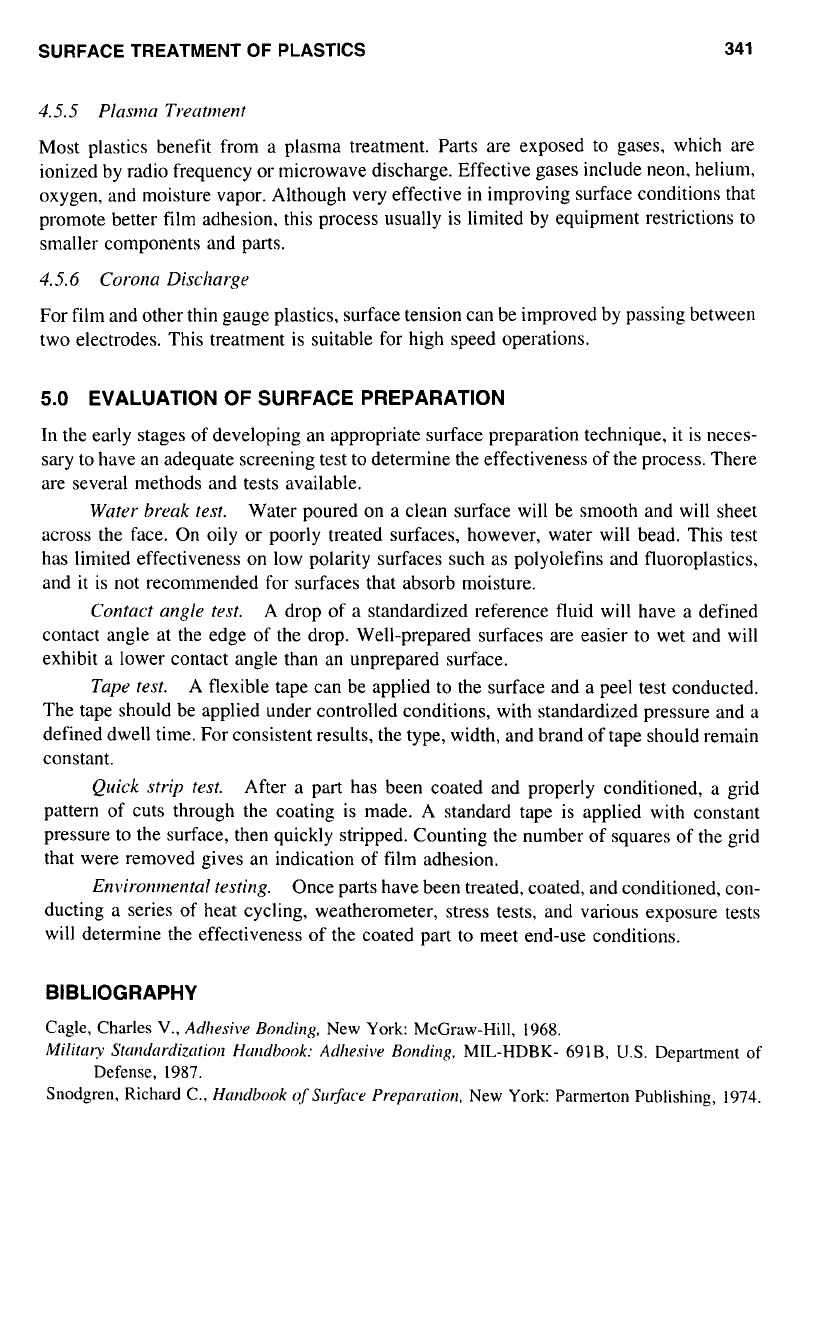
SURFACE TREATMENT
OF
PLASTICS
341
4.5.5
Plnsrm
Treutrnent
Most plastics benefit from a plasma treatment. Parts are exposed to gases, which are
ionized by radio frequency or microwave discharge. Effective gases include neon, helium,
oxygen, and moisture vapor. Although very effective
in
improving surface conditions that
promote better film adhesion, this process usually is limited by equipment restrictions to
smaller components and parts.
4.5.6
Corona Discharge
For film and other thin gauge plastics, surface tension can be improved by passing between
two electrodes. This treatment is suitable for high speed operations.
5.0
EVALUATION
OF
SURFACE PREPARATION
In the early stages
of
developing an appropriate surface preparation technique, it is neces-
sary to have an adequate screening test to determine the effectiveness of the process. There
are several methods and tests available.
Water
break
test.
Water poured on a clean surface will be smooth and will sheet
across the face. On oily or poorly treated surfaces, however, water will bead. This test
has limited effectiveness
on
low polarity surfaces such as polyolefins and fluoroplastics,
and it is not recommended for surfaces that absorb moisture.
Contuct angle test.
A drop of a standardized reference fluid will have a defined
contact angle at the edge
of
the drop. Well-prepared surfaces are easier to wet and will
exhibit a lower contact angle than an unprepared surface.
Tupe test.
A flexible tape can be applied to the surface and a peel test conducted.
The tape should be applied under controlled conditions, with standardized pressure and a
defined dwell time. For consistent results, the type, width, and brand of tape should remain
constant.
Quick
strip
test.
After a part has been coated and properly conditioned, a grid
pattern
of
cuts through the coating is made. A standard tape is applied with constant
pressure to the surface, then quickly stripped. Counting the number
of
squares
of
the grid
that were removed gives an indication of film adhesion.
Environmental testing.
Once parts have been treated, coated, and conditioned, con-
ducting a series
of
heat cycling, weatherometer, stress tests, and various exposure tests
will determine the effectiveness of the coated part
to
meet end-use conditions.
BIBLIOGRAPHY
